Furman University is an HWCU — a Historically White College or University. Until Jan. 29, 1965, we were an exclusively white institution. The enrollment of Joseph Vaughn more than half a century ago signaled the beginning of a new era in our school’s history, an era in which the grip of racism on our policies and on our people has gradually diminished. Now is certainly not the time, however, to reassuringly pat ourselves on the back. Racism and antiracism, Ibram Kendi argues, are not stable identity markers, like brass nameplates on a desk. Rather, they “are like peelable name tags that are placed and replaced based on what someone is doing or not doing, supporting or expressing in each moment.” This moment, like all moments, calls for sustained antiracism, not just complacent adherence to status-quo social expectations. To their credit, the leaders of our historically white university have recognized this. On Joseph Vaughn Day, our community not only looked back on past progress but also looked ahead towards the future.
In a political culture driven by outrage and short attention spans, it can be tempting for academic institutions to rush into approaches to racism that are high on histrionics but low on substance. In contrast, Furman’s new Strategic Diversity Plan (SDP) is wise and well-thought-out, incorporating input from the most important stakeholders in this conversation — Black students and alumni — and seamlessly integrating with our new vision, mission, and values statements. In an era in which speech and thought in academic spaces are sometimes needlessly sacrificed in the name of justice, the statements released last week reflect a holistic, harmonic view of truth and justice. Protecting “cognitive diversity” and “freedom of inquiry” is necessary for the pursuit of truth, and the pursuit of truth is essential to the quest for justice. The announcements from President Davis on Jan. 29 were encouraging on both fronts.
Plans are not meant for the ether, however: they must be put into action. As a good long-term plan, the SDP is broad and leaves room for interpretation. This makes sense, as the issues we will face in 2050 are likely to be quite different from those we are called to address today. But the admirable goals laid out in the plan will not be accomplished without concrete changes in policy. I would like to suggest that we start by abolishing legacy admissions at Furman.
You may remember learning about legacy admissions when you were applying to colleges. Almost all 4-year institutions employ some version of this system. You are considered a “legacy” if you are the child or sibling of an alum. While admission is by no means automatic, legacies definitely have a leg up. At the most elite schools in the country, legacies can be two to four times as likely to get in compared to their peers. Colleges typically don’t hand out admissions decisions on a silver platter, and many legacies are strong applicants anyway. But at the end of the day, this system functions as an arbitrary and unhelpful form of affirmative action.
The first three underrepresented groups listed in the SDP are students of color, first generation students, and low-income students, and the first goal in the plan is to “improve the recruitment, retention and advancement” of students from these groups. Eliminating the consideration of legacy status in the admissions process would help our school make significant progress towards meeting this goal. As mentioned above, the legacy system privileges the children or siblings of Furman alumni. Such applicants are highly unlikely to be first generation college students, and they disproportionately come from white and higher-income families.
While there is nothing inherently wrong with legacy status, the arguments in favor of factoring it into admission are not very persuasive. The system is often defended on financial grounds: university budgets rely on donations, and alumni with family members at the school may be more likely to give. More broadly, thicker family ties to an institution are thought to enhance school spirit and a sense of community among students and alumni long after graduation. Yet schools that have abandoned the legacy system appear to be doing fine financially, and I doubt that the feelings of connectedness among their students and alumni have been meaningfully dampened. This system is also not an ancient tradition. There are reasons people tend not to talk about it, and my hunch is that only a select but vocal few will care if it is done away with. Abolishing the legacy system would truly begin to level the playing field of admissions, making The Furman Advantage more accessible to more people.
“What is a legacy? It’s planting seeds in a garden you never get to see.” All of us at Furman today get to enjoy the fruit of a garden that was planted by others — racist theologians like James C. Furman, renaissance women like Mary Judson, skilled engineers like Carl Clawson, courageous visionaries like Joseph Vaughn. There is beauty and goodness in this garden that we ought to appreciate. But injustice is also our inheritance, and inertia is its engine. That is why Kendi argues that being “not racist” is not enough. As with all good things in life, progress towards a more diverse, equitable, and inclusive Furman will require effort. Is it effort we are willing to expend, not only for our own sake, but for those who come after?
